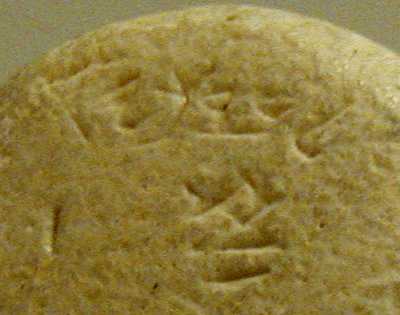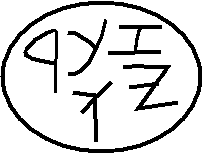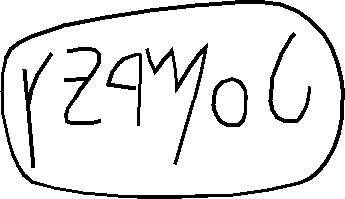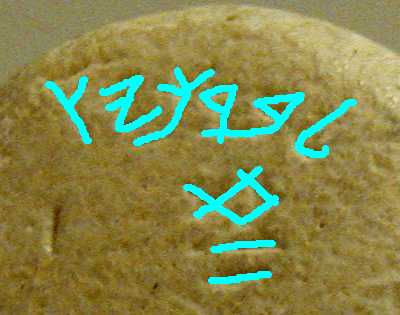Michael Welch commented via E-mail that the letter I tentatively identified as a Vav/Waw may actually be an ancient exclamation point as seen WSS #1183 ("LSR!", "[seal] of Sar/governor"). Though its reading is difficult due to its fragmentary condition, based on its design, it's not necessarily an Israelite seal. A. Lemaire thought it could possibly be Ammonite (in Syria vol. 63, 1986, pp. 305-25), an opinion also shared by W.A. Aufrecht ("Corpus of Ammonite Inscriptions", 1989, #128); U. Hubner & E.A. Knauf suggested Judahite (in ZDPV vol. 110, 1994, pp. 82-7).
Here's yet another rendition of my photo; this time it's the actual seal, but mirrored so the inscription can be read naturally:

The following day I happened to be browsing backissues of BAR magazine, & noticed 2 Israelite seals excavated at Dan. Last week I noted with reserve that my reading "LBRKYU" was "an unlikely spelling" (i.e., "-YU" rather than the more common "-YEU"); however, both of these seals from Dan terminate with the same orthography. Alternate photos appear in WSS, so I made composite drawings (which will eventually appear in my next hardcover, "LMLK--A Mystery Belonging to the King vol. 2").
"ZKRYU" = "[seal] of Zechariah"; a name meaning "God (Yahweh/Jehovah/LORD) Remembers" (WSS #669):

Two jar handles with this seal impression are known. One was excavated from Tel Dan in 1988 (Area B, Stratum II, Locus 7129, find #23677/1); the other's from et-Tell (Bethsaida). WSS dates it to the mid-8th century.
"LOMDYU" = "[seal] of Immadiyo"; a name meaning "God (Yahweh/Jehovah/LORD) is With Me" (WSS #692):

Three jar handles with this seal impression are known, all from Tel Dan (1974, Area B; 1986, Stratum II or III, Room 9024, find #30655; 1991 Area M, Locus 8321, find #21175/1). WSS says the excavator dates them to the 8th or late 9th century.
Note the similarity between the Resh of the ZKRYU seal & the Dalet of the LOMDYU. The latter could possibly be read as a Resh rather than a Dalet, which would then render a name similar to the well-known Israelite king, Omri (1Kings 16), albeit with a theophoric suffix: "LOMRYU" or "[seal] of Omria", a name that almost sounds like a cross between "Omri" & the city he established as the capital of Israel, "Samaria" (although the Hebrew spelling is actually SMRUN, which is a completely different ending than the name used in most English Bibles; there goes that theory down the drain).
I'm tempted to go off on a tangent about stamped jar handles in Israel vs. Judah, but will save it for LMLK vol. 2. For now I'd prefer to remain focused on the seal-weight. For comparison, consider again the seal-weight's inscription (highlighted by me on this mirrored photo):

Note the similarity between the LOMDYU's Vau & that of the seal-weight & the LMLK S2DR, yet the difference between those three & the more common rendering in the ZKRYU seal.
Note the similarity between the LOMDYU's Mem & the LMLK H4C seal, which I already pointed out last week has a "BR" ligature similar to the Cincinnati seal-weight.
Mike Welch also called my attention to the SQL HMT ("shekel of Hamat/Hamath") bronze weights, considered either Paleo-Hebrew or Paleo-Aramaic, which could be related to the Biblical border/entrance city in modern Syria (32 OT references spanning from Numbers 13:21 to Zechariah 9:2). Three bronze weights marked with Aramaic inscriptions indicating the value of the weights appear in "The Adoniram Collection of West Semitic Inscriptions" by Robert Deutsch & Andre Lemaire (p. 41; more details available on Robert Deutsch's website than on Amazon's), which they compared to the HMT weights:
"Similar lentoid or dome-shaped weights of the 8th century B.C.E. bear the name of Hamath (P. Bordreuil, "Metropoles et Metrologies Poliades" in Semitica 43-44:9-20, 1994, no. 2: SQL HMT 13.3 gr., & no. 5: ST SQL HMT 7.6 gr.)."
The three bronze weights in the Adoniram book all have inscriptions but no sheqel symbol:
- Weight #27, "H T ' S R H" meaning "Eleven"
- Weight #28, "S A R Y S Q L" meaning "Rest of a Shekel"
- Weight #29, "H M S H" meaning "Five"
Also note that the orientation of the sheqel symbol & bars on the Cincinnati seal-weight is identical to that of the unprovenanced LMLK weight published in "Forty New Ancient West Semitic Inscriptions" by R. Deutsch & M. Heltzer. However, the orientation of the Paleo-Hebrew inscription with respect to the sheqel symbols on both of these weights is different. This could be due to either the purpose of the inscription (i.e., mirrored for stamping clay separate from the weighing process vs. non-mirrored for qualifying the weight) or it could indicate that the "LMLK" inscription was a late addition (possibly even a modern forgery to add market-value to the artifact).
Song of the week: "The Wonder Of You" by Elvis Presley (click the song title to visit Amazon; click here for a 25-second sample; 328kb). What a tough decision! Runners up included:
- All I Want is You--U2
- Falling in Love with You--Gary Moore
- Good to See You--Vangelis
- How Can I Leave You Again--John Denver
- I Believe You--The Carpenters
- I've Done Everything for You--Sammy Hagar
- Should I Let You In--Belinda Carlisle
- You (Got It)--The Babys
G.M. Grena

No comments:
Post a Comment